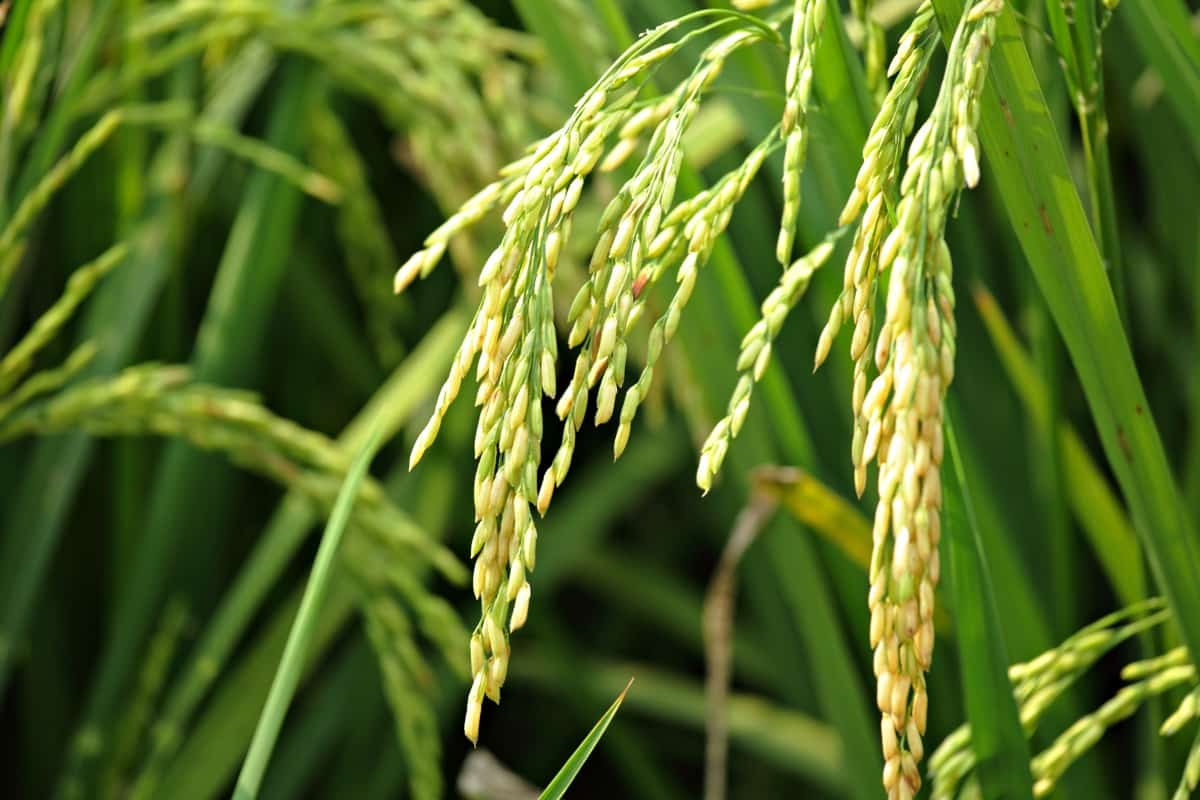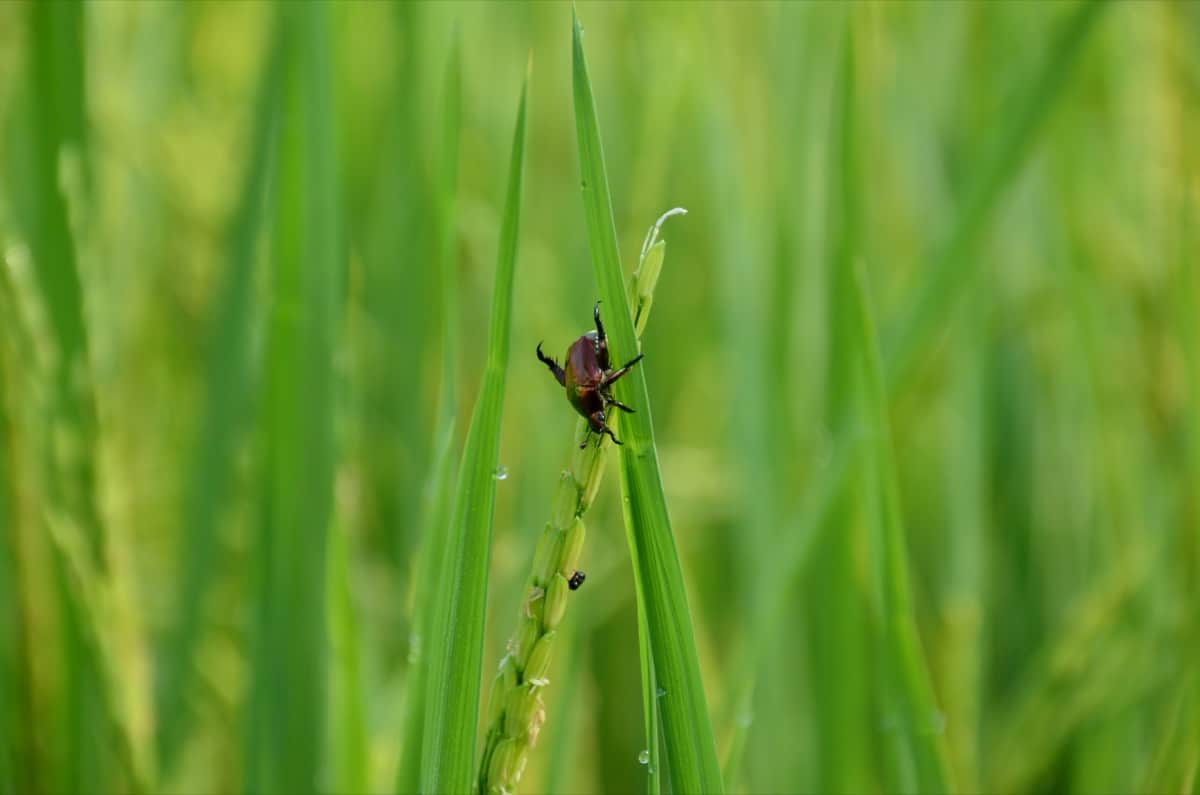Welcome to our blog on managing damaging insect pests in rice! Insects can wreak havoc on rice crops, causing significant damage and reducing yields. Identifying the symptoms of insect infestations is crucial for timely intervention. We’ll explore common signs to watch out for and explore effective prevention and management strategies.

By understanding these pests’ life cycles and habits, we can implement sustainable methods to protect our rice fields. Join us as we navigate this informative journey and learn how to safeguard our rice crops from these pesky invaders.
Major Damaging Insect Pests In Rice/Paddy
In India, rice faces a higher number of insect attacks compared to any other cereal crop. Among these pests, we have the major insect pests that significantly threaten rice cultivation. These include planthoppers, stem borers, gall midge, leaf folders, earhead-cutting caterpillars, rice case worms, rice hispa, and more. These pests can cause severe damage to rice plants, affecting their growth and ultimately reducing yields.
How to Manage Insect Pests In Rice/PaddyDamage: Symptoms, Prevention, and Management
BPH or Brown Plant Hopper (Nilaparvata lugens)
- Identification: Look for a prominent tibial spur on the 3rd leg.
- Damage Symptoms: Hopper burn.
- Prevention and Management: Use Triaziphos insecticide.
- Additional Information: Economic Threshold Level (ETL) is 1 BPH per tiller. BPH is a vector for the grassy stunt virus.
Earhead bug (Leptocorisa oratoria)
- Identification: Slender bug with a characteristic odor from the adult.
- Damage Symptoms: Chaffy grains and black spots on the feeding surface.
- Prevention and Management: Maintain ETL at five bugs per earhead and use Quinalphos insecticide.
- Additional Information: Also known as the Gundhi bug.
Gall midge (Orseolia oryzae)
- Identification: It is a fly with a yellowish-green color, similar to a mosquito.
- Damage Symptoms: Formation of silver shoots and absence of panicles.
- Prevention and Management: Monitor for 10% silver shoots and consider using the parasite Platygaster oryzae.
- Additional Information: Silver shoot is also known as onion leaf.
GLH or Green Leaf Hopper (Cicadella viridis)
- Identification: Bright green adults with black spots.
- Damage Symptoms: Yellowing or drying of leaves starting from the tip.
- Prevention and Management: Maintain the population at five insects per hill before flowering.
- Additional Information: GLH is a vector for the tungro virus.
Grasshopper (Hieroglyphus banian)
- Identification: Green body with transverse black lines above the pronotum.
- Damage Symptoms: Irregular feeding on leaves and presence of left midrib.
- Prevention and Management: Use Chlorpyriphos insecticide.
- Additional Information: Grasshopper is polyphagous.
Rice hispa (Dicladispa armigera)
- Identification: Spiny body is a characteristic identification mark.
- Damage Symptoms: Irregular translucent white patches, blisters near the leaf tip, and a field burnt appearance.
- Prevention and Management: Consider systemic insecticides.
- Additional Information: The adult beetle is known as an imago.
Rice-horned caterpillar (Melanitis ismene)
- Identification: Brown wings with black spots on all wings.
- Damage Symptoms: Damage occurs on the marginal sides of the leaves.
- Prevention and Management: Use systemic insecticides.
- Additional Information: Exhibits erratic flying behavior.
Leaf roller (Cnaphalocrocis medinalis)
- Identification: Yellowish-green translucent larva and a moth with horizontal bands and black wing margins.
- Damage Symptoms: Longitudinally folded leaves.
- Prevention and Management: Introduce Trichogramma chilonis, an egg parasitoid.
- Additional Information: ETL is 10% damaged leaves.
Mealybug (Brevennia rehi)
- Identification: Reddish appearance.
- Damage Symptoms: Stunted plants in patches.
- Prevention and Management: Implement systemic insecticides.
- Additional Information: Nymphs cluster in the leaf sheath.
Rice case worm (Paraponyx stagnalis)
- Identification: Pale yellow translucent larvae and pale brown wavy markings on adults.
- Damage Symptoms: Whitish papery leaves with the presence of leaf cases.
- Prevention and Management: Use systemic insecticides.
- Additional Information: Also known as rice case bearer.
Rice Skipper (Pelopidas mathias)
- Identification: Slender green larvae and light brown wings with orange markings.
- Damage Symptoms: Downside rolling of leaves and the presence of webbing.
- Prevention and Management: Apply systemic insecticides.
- Additional Information: Also known as black branded swift.
Stem borer (Scirpophaga incertulas)
- Identification: Pale yellow with a dark head, reddish-brown males.
- Damage Symptoms: Formation of dead heart in plants.
- Prevention and Management: Use Trichogramma japonica, an egg parasitoid.
- Additional Information: Dead heart ETL is 25%.
Swarming caterpillar (Spodoptera Mauritania)
- Identification: Yellowish-white lateral stripes and dark grey-brown adult moths.
- Damage Symptoms: Presence of cut seedlings in large quantities.
- Prevention and Management: Implement systemic insecticides.
- Additional Information: Also known as armyworm.
In case you missed it: How to Treat Paddy Diseases: Causes, Symptoms, Disease Cycle, and Control

Thrips (Stenchaetothrips biforms)
- Identification: Pale yellow larvae and dark brown, slender adults with hair-fringed wings.
- Damage Symptoms: Discolored leaves and terminal rolling of leaves.
- Prevention and Management: Consider systemic insecticides.
White-backed plant hopper (Sogatella furcifera)
- Identification: White band on the back.
- Damage Symptoms: Hopper Burn
- Prevention and Management: Use systemic insecticides.
Whorl maggot (Hydrellia sasakii)
- Identification: Yellow larvae and dark gray adult flies.
- Damage Symptoms: Yellowish-white blotches and drooping of tip leaves.
- Prevention and Management: Apply systemic insecticides.
- Additional Information: ETL is 25% damaged leaves.
Yellow hairy caterpillar (Psalis pennatula)
- Identification: Yellowish-brown larva with red stripes and dark brown-colored moth forewings.
- Damage Symptoms: Defoliation of leaves.
- Prevention and Management: Utilize systemic insecticides.
Plant Damage Caused by Rice Insects
Root Feeders
- Termites and the rice water weevil are examples of root feeders.
- Termites occur in patches in West African upland rice fields and can kill plants, especially during low rainfall.
- The water weevil is a major pest of irrigated rice in the USA. The larvae severely reduce the root system, leading to poor plant growth and low yields.
Stem Borers
- Stem borers, such as the sugarcane and rice stalk borer, lay eggs on rice leaves, and the larvae bore into the stem.
- Feeding during the vegetative growth stage causes a “dead heart” and prevents panicle formation, resulting in no grain production.
- Feeding during the reproductive stage causes “whiteheads,” where the panicles are unfilled and whitish.
Leafhoppers and Planthoppers
- Leafhoppers and planthoppers attack the plant’s aerial parts and basal portions by sucking plant sap.
- Severe damage results in plants drying up and resembling fire-damaged plants, known as “hopper burn.”
- These insects are also vectors of serious rice virus diseases, transmitting diseases like rice tungro and grassy stunt viruses.
Defoliators
- Various insects feed on rice leaves, including beetles, lepidopteran larvae, and grasshoppers.
- Defoliation reduces photosynthetic capacity and lowers yields, although plants in the tillering stage can tolerate some leaf damage.
Grain Sucking Insects
- Stink bugs penetrate developing grains and remove the white fluid, causing unfilled grains or “pecky rice.”
- Pecky rice may have reduced market value due to subsequent staining by bacteria or fungi.
Yield Losses Caused by Rice Insect Pests
- Historical records show substantial yield losses caused by insect pests, such as locust outbreaks in Japan.
- Estimate yield losses caused by insects range from 2% in Europe to 31.5% in Asia.
- Recent experiments indicate that insect control contributes to yield increases, highlighting the importance of managing pests.
Factors Affecting Extent of Insect-Caused Yield Losses in Rice
- Changes in cultural practices, including multiple yearly crops, increased chemical use, irrigation, and plant densities, have influenced pest abundance.
- Continuous cropping and increased irrigation favor pests like the whorl maggot and rice caseworm.
- The brown planthopper has become a major pest due to resurgence-inducing insecticides, which disrupt predator-prey balance and increase the population.
In case you missed it: Rice Tungro Disease Management in Paddy: Symptoms, Treatment, Chemical, Biological, Natural, and Organic Control

Conclusion
In managing insect pests in rice, it is necessary to identify and understand the damage symptoms caused by different pests. Implementing preventive measures, such as cultural practices and chemical control when necessary, can help manage and minimize insect damage in rice crops.
- Types of Fungicides Used in Agriculture
- Common Issues in the Fruit Development Stage of Pomegranate Farming
- Fruit Development Issues in Papaya: Easy Solutions and Treatment
- Soil-Borne Diseases and How to Protect Your Plants
- Practices to Prevent Disease Spread in the Garden
- From Wilted to Thriving: How to Treat Root Rot Naturally in Houseplants
- Natural Remedies to Cure Brown Spots on Fig Tree Leaves
- Natural Solutions for Poinsettia Problems: 100% Effective Remedies
- How to Control Calla Lily Problems: Natural Remedies for Leaf and Flower Problems